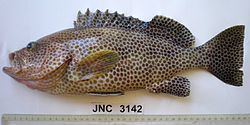Kingdom Animalia Genus Epinephelus Higher classification Epinephelus Rank Species | Family Serranidae Scientific name Epinephelus chlorostigma Phylum Chordata Order Perciformes | |
 | ||
Similar Grouper, Epinephelus, Comet grouper, Serranidae, Dotted grouper | ||
Brown spotted reef cod epinephelus chlorostigma
The brown spotted reef cod (Epinephelus chlorostigma), known as Souman or Hamour-e Khaldar-e Qahvei in Persian and commonly as brownspotted grouper in English, is a fish belonging to the family Serranidae.
Contents
Description
E. chlorostigma can reach a length of 12–75 cm and a weight up to 7 kg. It is one of the largest coral dwelling fish. It has large pectoral and caudal fins that enable it to move and maneuver quickly through the water. It has a pale green gray body covered with small circular brown blotches, except for its belly which is lighter in color. When aroused, the fish is able to change its body shading according to its surroundings. Five dark brown vertical bands appear along the body. Its mouth is very large and capable of being opened to the width of the body diameter.
It feeds on crabs, cuttle fish and almost any other small fish. It is shy and lazy in its habits. When feeding, E. chlorostigma hides in its cave opening or in between corals and waits for some unsuspecting prey to pass by close enough to be pounced upon and swallowed whole. Predators are usually warned off by an impressive display of mouth gaping.
Cooked hamour in all its forms (stew, grilled, or fried) is a highly prized dish in Southern parts of the Persian Gulf and "baby hamour" is a delicacy found numerous upscale restaurants.
Habitat
It is a reef-dwelling fish and prefers coral caves or rock crevices in which to live, at a depth of 4 to 280 m.
Distribution
This species can be found in the Persian Gulf, in the Indian Ocean and in western Pacific Ocean.
Parasites
As other fish, the brown spotted reef cod has many parasites, including several species of monogeneans on its gills, including Pseudorhabdosynochus epinepheli, and the digenean Neidhartia lochepintade in its intestine. This parasite species was named for the New Caledonian name of the fish, "loche pintade".
